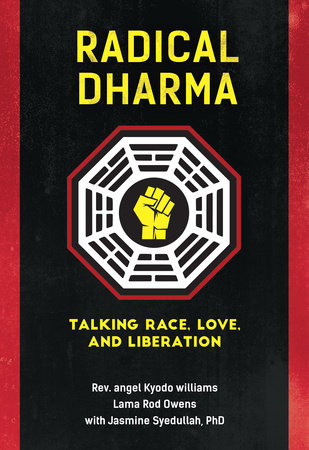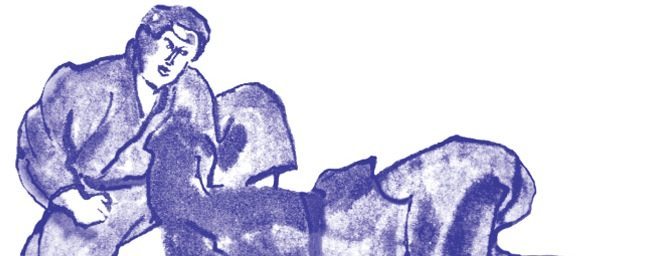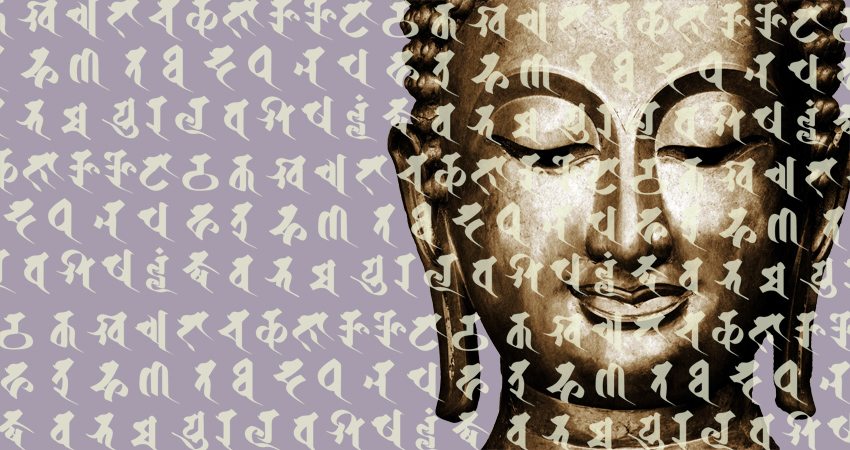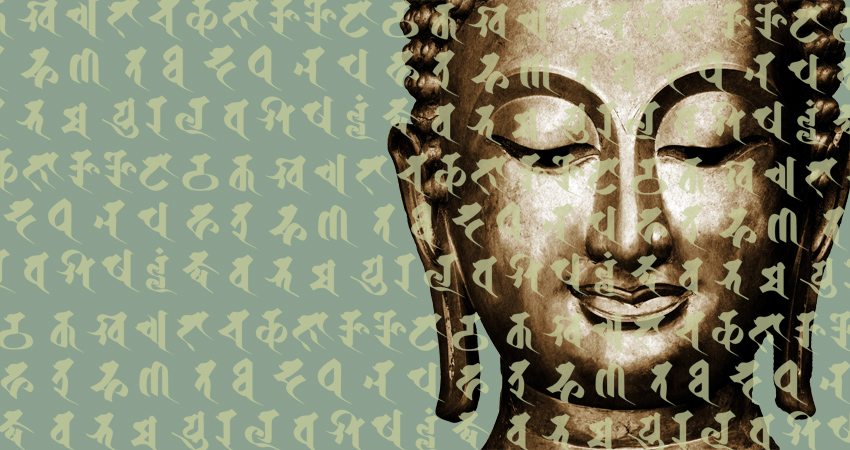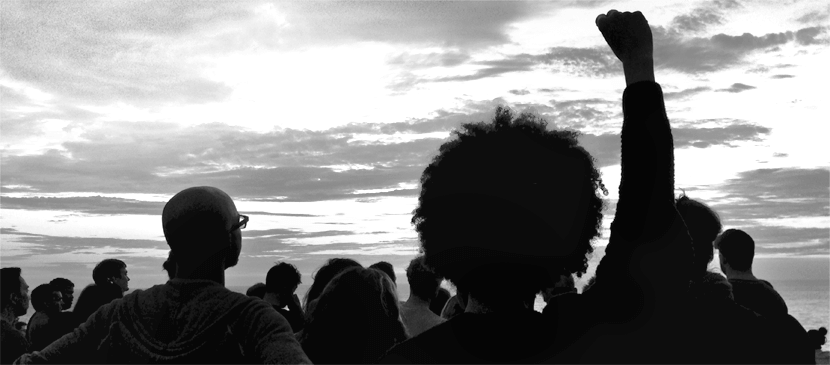
Radical Dharma: Remembering in Seven Movements
Categories: Excerpt Society & Politics Spirituality & Religion
Tags: Buddhism Social Change Christianity Lama Rod OwensRemembering in Seven Movements
I am wondering what it has meant for me to leave home. I am thinking of the long journeys that have taken me from one locale to another, from one country to another; the journeys over waters and mountains, through deserts, through places haunted and infested, through dark places, and darkness itself. I am thinking of wanderings from lover to lover, from glimpses of light to memories of light, away from identity to identity and back again; from one kind of ignorance to another. I am thinking of movement and memories of movement, always leaving and having to return again and again. Never landing in a place but somehow feeling that the place lands on me. Teetering between the past and the future. Avoiding the present because dealing with right now is sometimes the hardest thing to do.
The most difficult part of leaving is remembering what has been left, articulating the why of my leaving, regardless of how it may put me at odds with those closest to me. Yet, these have been the choices that I have most often made. I have seen them as movements.
As a young Black boy growing up in the South, my love of Black root music of traditional gospel, jazz, R&B, and soul was punctuated by a growing appetite for classical European music. The genre of music was exotic to me. By college, I had discovered the genre of concert requiems. I knew nothing of requiems or Catholicism at the time, but what moved me most about the genre was how it evolved from Eucharist services for the dead to emotional and dramatic performance works that often embodied and echoed the human struggle to make meaning of death and impermanence. Each movement of the requiem was a shift to permit the listener and performer to be creatures experiencing the suffering of old age, sickness, and death. These are the same experiences that the Buddha longed to make meaning of and which eventually motivated him to leave his home in search of transcendence from these sufferings. As I have moved in my life, I have also experienced the death of who and what I was before the movement. I remember not as an act of moving back into the past but as a memorial to the struggle of movement. I remember to offer myself the grace to grieve for the person I used to be. In the sentiment of my home community, I may not be where I’m going, but I am grateful that I’m not where I used to be.
First Movement
Growing up in church, I never really understood Christianity or Jesus. It was never the theology that drew me to church. It was first and foremost the will of my mother who never gave me a choice! Yet, as I remember, I recall that it was something deeper that drew me to church. Like most Black folks now and since slavery, I was drawn to the Black church because it was the only place I felt protected, affirmed, and seen. The Black church was, among many things, a strategy to negotiate the brutality of systematic racism and the unrelenting demands of white supremacist culture to forget centuries of psychophysical trauma. My mom’s insistence that I be present was part of how both she and the church loved me. It was and still remains invaluable for the community. It was how I survived. My church upbringing was my first lesson in what a spiritual community was and its power in shaping the lives of all its members.
I rarely agreed with what I was learning, though. I never understood who Jesus was and felt that God was like an old, angry white man. I lived in the South, and old, angry white men were dangerous, so I grew up being afraid of God. On top of that, I slowly began to notice and accept my overwhelming sexual attraction to other men. I barely remember any anti-queer sentiments openly expressed growing up, but what I do remember was the silence that pertained not only to queerness but also to sexuality. The silence was constricting, and it spoke just as loudly as any sermon on the sin of homosexuality. It wasn’t until I graduated from high school that I was able to gain distance from the community in order to start articulating my inner experience of my sexuality and body as it related to other male bodies.
This particular movement was one of remembering love but privileging the need to speak my own truth.
Second Movement
I ended up attending a small liberal arts college in my hometown that was not very diverse. Because of that and its struggles as a historically white supremacist, heteronormative, queerphobic institution, I would later start referring to the college as a plantation. Though the reference started as a joke born out of my eventual burnout at the school, it was important for me to articulate my experience of the school. The college, much like my later graduate institution, did not actually care about me as a person whose particular intersectionality should be recognized and embraced. The trauma for othered bodies in institutions is the expectation that we should be grateful for being allowed in the door, and, once we are in the door, not much effort is made for us to have a seat at the table. My experience was like being told to sit in the corner and shut up. I call it being a causality of white supremacist grace. Unfortunately, this is not just what many institutions mean by diversity; this is what they mean by inclusivity as well. Despite these criticisms, I came to appreciate my education, relationships with professors and classmates, and the uniqueness of the campus.
However, there were some other experiences. First, after enrolling in a Christian ethics class and finally realizing that I really wasn’t a Christian (and according to some of my white evangelical classmates, I was neither ethical nor moral), I knew that I was experiencing a lot of anger toward God. I experienced so much marginalization because of my sexuality and progressive beliefs from people claiming Biblical authority, I dropped the class, scapegoating a lot of rage toward God. In my mind I told him to fuck off and broke up with him. I was no longer interested in being in an abusive relationship. It was perhaps here that the example of Christian practitionership was the hardest for me to reconcile, and I struggled to see the practice as it was demonstrated to me as nothing but psychic violence informed by white supremacy, patriarchy, and class maintenance.
The second experience was 9/11. I was a senior and woke up that day to the feeling of the world falling apart. By the end of the day, I had experienced my first and only anxiety attack as many of my peers were struggling with their own emotional breakdowns. I, like many other people that day, felt a violent jolt. I remember thinking to myself, “People are pushed hard enough to fly planes into skyscrapers! What the fuck!” After that I noticed a significant shift in my community work. Looking back, I actually developed my own personal version of the Four Noble Truths of Buddhism. I understood more intimately that I was suffering, that other people were suffering, that I was a part of other people suffering, and that I was charged with addressing my suffering and the suffering around me. I was understanding that the stakes were incredibly high. That was the beginning of my activism.
The third experience was one that would take years to heal emotionally from. I was new to being an editorial writer for my school paper. I wanted to write a four-part series exposing the obstacles of safer-sex education at the school and began the series with a humorous look at sex and sexuality. That five-hundred-word column changed my life. It ran on Thursday, and by Monday morning of the following week, I had been fired from my on-campus job and became the center of a heated debate over censorship. It triggered perhaps the darkest period of my life. I often tell people that I get how people lose it and conceive of mass shooting and/or suicide. I can’t tell you how I made it through a month being openly criticized by students and faculty in public and through the paper. I felt that I had fallen from grace as the “good Negro” and became “that nigger.” It was then I began to feel like I was on a plantation. What I learned was the truth of the violence that can come from making white people uncomfortable.
This movement was about survival and experiencing suffering while articulating my truth and learning how to take responsibility for all of it.
Third Movement
I moved to Boston after my graduation. This move was about seeking community to restore the woundedness of my time in college. I sought, above all, to be a member of a community in which my principal struggle was not fighting being othered because of my race, religious beliefs, sexuality, or political views. I moved into an organization called Haley House that was founded in the spirit of the Catholic Worker Movement. It was here that many of my more radical and anarchist social views commingled. It was a time marked by intense devotion to service and activism and living with people dedicated to challenging the systems that create inequality and violence.
And though the community was founded in the tradition of the worker movement, most of my community mates were dharma practitioners or at least meditators. I had taken a world religions class in college in which I found the study of Buddhism interesting, but I felt a stronger pull toward Islam as it was an Abrahamic religion more familiar to my Christian roots. Thus, I did not walk away with an intellectual fascination with dharma. Early during my stay in the community, however, I became very interested in Buddhist philosophy, even meeting some of the teachers my community mates practiced with. I tried meditating but hated it! Still, I was drawn to Buddhism and was surrounded by practitioners. I even took a short break to travel in Asia for the first time, visiting India, and still I did not develop an interest in meditating. It was after my trip to Asia that I no longer had a choice to practice or not.
This movement was about the first calls of dharma.
Fourth Movement
I didn’t know what clinical depression was until I realized that I was clinically depressed. For me, it was a like demon entering my body and refusing to leave. After my time in Asia, I returned to a sense of heaviness and depleted motivation. Over the course of a few months, my perception of the world devolved into slick grayness. It was hard to make sense of things. I was no longer happy. It was difficult to connect to joy, and when I did, it would always disappear. I couldn’t get out of bed, and I spent much of my time alone, isolated in my room listening to Nell Carter sing “Mean to Me” from the Broadway show Ain’t Misbehavin’. The song is still one of my favorite pieces, but back then it posed a vital question: Why are you so mean to me? I don’t know who the you was, but I felt oppressed, drained, and numb, like I was dying. The demon was killing me.
One day, I made a vow to myself: I would not die or fade into the grayness. I had been in therapy a few months but didn’t find it that helpful and did not have insurance or money to continue treatment. However, my instinct told me to seek guidance from those around me. The community attracted folks of many faith traditions, so I decided to meet with some of them, asking about their paths and what advice they had for me. The meetings were rich, but I was still searching. When a friend recommended that I just start taking medication to manage the illness, I felt a strong and almost violent revolt in my mind. I knew intuitively that if I started meds, I would never be able to get off of them. But I also recognized that I was poised to get much worse with the illness. So I made myself a promise to seek out every possible solution, and when there was nothing left to seek, then medication would be the last resort. These kinds of declarations have a way of opening unexpected doors.
This movement was about learning how to care for my suffering.
Fifth Movement
An interesting and fantastic door did open, and I found myself sitting with a Christian healer who promised to help me. I decided to trust this healer. Among the various forms of energy cleansings and aura adjustments, I ended up being taught how to meditate. I had been given meditation instructions before, but now the context was simple and direct: meditate or die. I chose meditation. Along with meditation came a whole lifestyle overhaul, which included nutrition, exercise, limiting the violence I consumed from media, limiting negative folks in my life, and praying to God. By this point in my life I knew that I was at my rock bottom; I was willing to pray to anyone, maybe even the Devil himself! And slowly the healing happened. I was emerging from layers of suffering and darkness, realizing that I had been depressed for longer than I realized, maybe even since high school. As the heaviness lifted, meditation became easier until I had established a daily, simple, open-awareness practice.
My wounding around Christianity was also healing as well. Eventually, I ended my work with the healer and found myself back in the world a new person. I was drawn back into the church and active Bible study. My time in the community had also brought me into a relationship with Christians who modeled their life after Jesus’s, and through their example I was finally connecting to Jesus’s teachings. I was moved. I was still meditating voraciously. Yet, though I loved being back in church, I was still not a Christian. Theology did not come close to how I deeply felt about reality. I needed teachings that told me the truth about how things really were because part of me wanted to do more than make do, but to ultimately wake up.
This movement was about learning how to move through suffering, finding Jesus, and hearing dharma calling even more clearly.
Sixth Movement
When I knew that Dharma was my path, I once again started accompanying my community mates to sittings. This time I was like an open container taking everything in and putting as much as I could into practice. One of the most immediate realizations I experienced was the understanding that dharma communicated how I had felt about the world for as long as I could remember. Dharma revealed the extraordinary complexity of my own experience. Dharma didn’t just tell me about love and compassion; it provided a method to become love and compassion. It was through Dharma that I finally understood who Jesus was because I was able to place him within the context of a bodhisattva whose principal motivation is to achieve spiritual awakening to liberate all beings. Most importantly, my formal introduction to karma helped me to see that there is a reason and order behind the way in which things manifest. This understanding helped me take responsibility for my life and helped me to see that the suffering as well as the joy I experienced were related to the choices I had made in previous lives and that the choices I made now would likewise impact what I experienced in the future.
One afternoon, another door opened. I was reading the biography of Ani Tenzin Palmo, Cave in the Snow, when three aspirations popped up in my head. They were: 1) I must spend a part of my life in intensive retreat; 2) I must teach others the path of Dharma; and 3) being a Black American with deep concern for social and spiritual issues concerning people of color, I must teach and guide people of color on the path of Dharma in this life. I had never thought of any serious teaching path in Dharma before. I was still a beginner. I hadn’t found a teacher, taken refuge or the bodhisattva vow or anything, and here I was having instructions downloaded. It was both extraordinary and mundane at the same time. In the end, I simply said OK.
This movement was about beginning to live dharma out loud!
Seventh Movement
After the download, things moved quickly. I went from being that guy in the back of the meditation hall to entering intensive retreat and teacher training. I knew even then that I was tuning into decisions that had been made before this rebirth. I was just doing what I had been doing for lifetimes before. So much of my life since then has felt like following a script where the plot has already been laid out and my only job is to say my lines. Yet it is more than just saying my lines; it is enacting something that is in concert with my deepest wishes and aspirations.
Eventually, I met my root teacher and found myself in the traditional three-year retreat. My retreat practice provided the opportunity to look at years of pain and woundedness and engage in the struggle of making friends with it and releasing it. It was a time of developing deep love and compassion for myself as I accepted how I had resisted being loved for most of my life. It was also a time of deep forgiveness and learning to trust myself more. There are many ways to describe the experience: silence became the medium in which I was reborn into a sense of happiness and contentment. But overall, it ushered me into a period of thriving and flourishing in my life. After completing the retreat, I was authorized as a lama in the Kagyu School of Tibetan Buddhism.
This last and current movement has been about entering into a golden age in my life. This age is not free of suffering, but it is full of love and happiness that embrace my suffering. I am not the person I used to be. I have journeyed over many miles and tears to be able to share this story. In the end my movements have cost me. They have cost me my fear of becoming the person that I want and need to be. I write this only because I needed to read something like this when I was most lost in my wandering and aching.
In the words of Sweet Honey in the Rock, “We’re almost home.” One day, may all beings find their homeland after the great wandering.

